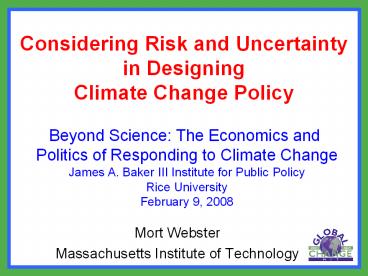Considering Risk and Uncertainty in Designing Climate Change Policy - PowerPoint PPT Presentation
1 / 30
Title:
Considering Risk and Uncertainty in Designing Climate Change Policy
Description:
Considering Risk and Uncertainty in Designing Climate Change Policy Beyond Science: The Economics and Politics of Responding to Climate Change – PowerPoint PPT presentation
Number of Views:144
Avg rating:3.0/5.0
Title: Considering Risk and Uncertainty in Designing Climate Change Policy
1
Considering Risk and Uncertainty in Designing
Climate Change Policy
Beyond Science The Economics and Politics of
Responding to Climate Change James A. Baker III
Institute for Public Policy Rice
University February 9, 2008
- Mort Webster
- Massachusetts Institute of Technology
2
Outline
- Motivation
- Three public policy questions
- Framework for analysis
- The MIT integrated assessment model
- Three analyses of uncertainty
- Long-term greenhouse gas targets
- Near-term greenhouse gas targets
- Regulatory design and cost-containment
3
Policy Questions about Climate Change
- What should be the long-term global
concentration/temperature stabilization target? - What should near-term global targets be?
- Emissions reductions in the next few decades
- How should greenhouse gas emissions regulation be
designed? - Instruments for cost-containment
4
MIT IGSM
5
Global CO2 Emissions(Deterministic)
6
Global Mean Temperature Change(Deterministic)
7
Global Mean Temperature ChangeUncertainty
8
Global Mean Temperature ChangeUncertainty
9
How Much Would You Pay to Spin the 750 or 550
Wheels?
750ppm Stabilization
550ppm Stabilization
No Climate Policy
10
BUTNot the right way to think about this problem
- Decisions about GHG reductions are not
once-and-for-all for the next century - More useful to ask
- What should we do for the next few decades if
- 1) we are uncertain today, and
- 2) we expect to reduce uncertainty, and
- 3) we can revise policies later?
- Related Question
- How much might we learn in 20 years? 30? 40?
11
Decision Under Uncertainty with Partial Learning
12
Summary Effect of Learning on Policy (2oC
Temperature Stabilization)
Source Webster, M.D., L. Jakobovits, and J.
Norton (2008). "Learning about Climate Change
and Implications for Near-term Policy." Climatic
Change (in press).
13
Current U.S. Climate Policy Debate
- Americas Climate Security Act of 2007
- Senators Lieberman, Warner
- Low Carbon Economy Act of 2007
- Senators Bingaman, Specter
14
Cost-Containment in the Proposed Bills
- Both have banking provisions
- Reduce more in initial years - not controversial
- What do we do if it costs more than we expect?
- Bingaman-Specter Bill
- Technology Accelerator Payment (Safety Valve)
- Lieberman-Warner Bill
- Borrowing (with some limits)
- Carbon Market Efficiency Board
15
Research Question
- Allocate emissions permits for 2015-2050
- What if the costs in the first period (2015) are
more than expected? - Is it better to have a
- Safety Valve
- Borrowing
- Intensity Target
16
Study Design
- Forward-looking MIT EPPA model
- Hypothetical emissions reductions
- Temporary shock to carbon price in 2015
- Compare four alternatives
- No Cost-Containment
- Borrowing
- Safety Valve
- Safety Valve with cumulative cap enforced
17
Compensated Safety Valve
- Chief objection to Safety Valve
- Cumulative cap not enforced
- If cumulative emissions matter, this is a problem
- Possible solution
- Have a Safety Valve with preset trigger price
- If original cap exceeded, use automatic formula
to distribute reductions in future permits
18
Impact of Banking
- Typical proposed emissions caps
- Start gradual, decrease sharply later
- Would induce net banking
- If you expect net banking
- No need for Borrowing or Safety Valve
- This analysis
- Hypothetical path of emissions caps
- No net banking
19
Hypothetical Policy
20
Borrowing defined
- In this analysis, Borrowing
- Is unrestricted (any year 2015-2050)
- Has no penalty or interest
- Performed with perfect foresight
21
Safety Valve vs. BorrowingUnder Uncertainty
- Monte Carlo simulation
- Uncertain shock to carbon price in 2015
- 1000 random samples
- Safety Valve
- Trigger price is constant across all shocks
- Initial guess
- Expected (non-shock) carbon price
22
Uncertainty in Carbon Price in 2015
23
Uncertainty in Carbon Price in 2015
Only Consider Higher Cost Outcomes
24
Carbon Price in 2015
25
Uncertainty in 2015 CO2 Emissions (Year of Price
Shock)
Emissions Cannot adjust To shock
Emissions adjust optimally to each shock
Emissions Over-adjust To shock (fixed trigger
price)
26
Uncertainty in Policy Costs(Cumulative over
2015-2050)
No Cost-Containment always has highest costs
Safety Valve always has lowest costs
Borrowing slightly better than Comp SV
27
Effect of Different Trigger Prices under
Uncertainty
- REF trigger price
- Expected (no-shock) carbon price
- Alternative trigger prices (relative to ref)
- 15,
- 30,
- -30,
- -70
28
Carbon Prices with Different Trigger Prices
29
Mean Welfare ImpactsCompensated Safety Valve
Too Low a trigger price is the most costly
30
Summary
- Emissions reductions
- Consider policy as risk management tool
- Decisions are not once-and-for-all
- Uncertainty is not a reason to delay
- Regulatory design
- Want some form of cost-containment
- Safety Valve costs less, abates less
- Compensated Safety Valve
- Can simulate borrowing
- Important to get the trigger price right
- Too low is worse than too high































